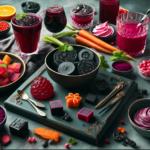INTRODUCTION
Whats the impact of natural colors on ice cream ? When we think of ice cream, our minds often conjure up vibrant scoops in a kaleidoscope of colors. These hues not only make ice cream visually appealing but can also significantly influence our perception of its flavors. While artificial food dyes have been widely used to create striking colors, the demand for natural alternatives
has gained momentum due to health concerns and the desire for more authentic experiences. In this blog, we delve into the world of natural colors and explore their intriguing impact on ice cream flavor perception.
THE SCIENCE BEHIND COLOR PERCEPTION
Before we unravel the connection between color and flavor, it’s essential to understand the science behind color perception. The human brain interprets the visible spectrum of light as different colors, creating a rich visual experience. When it comes to food, color plays a crucial role in our perception and expectations. We often associate specific colors with certain flavors, such as yellow for banana or green for mint.
THE ROLE OF NATURAL COLORS IN ICE CREAM
Natural colors derived from fruits, vegetables, and other botanical sources are increasingly being used in ice cream production. These hues are extracted through various methods, including juicing, pressing, and extracting pigments from plants. Unlike their synthetic counterparts, natural colors offer a more authentic and unadulterated representation of the ingredients used, creating a connection between the appearance and taste of the ice cream.
ENHANCING FLAVOR PERCEPTION
The impact of natural colors on flavor perception goes beyond visual aesthetics. Studies have shown that the color of food can significantly influence our perception of taste. For instance, researchers found that participants perceived red-colored beverages as being sweeter, while blue-colored beverages were associated with a more sour taste. By choosing natural colors that align with the flavors they represent, ice cream manufacturers can enhance the overall sensory experience and create a harmonious connection between color and taste.
CREATING A SENSE OF TRUST AND QUALITY
In recent years, there has been growing concern about the use of artificial food dyes and their potential health effects. Consumers are becoming more conscious of the ingredients in their food and are seeking natural alternatives. By incorporating natural colors into ice cream production, manufacturers can appeal to health-conscious consumers and convey a sense of trust and quality. The use of plant-based pigments adds an element of transparency, allowing consumers to feel more connected to the source of their food.
EXPLORING CREATIVE POSSIBILITIES
The use of natural colors opens up a world of creative possibilities in ice cream formulation. The vast array of botanical pigments provides an extensive palette for artisans to play with,
resulting in visually stunning and uniquely flavored creations. From the rich red of strawberries to the vibrant orange of mangoes, each natural color brings with it a
distinct flavor profile, allowing ice cream makers to craft delightful combinations that engage all the senses.
EMBRACING A SUSTAINABLE FUTURE
In addition to the health benefits and flavor impact, the use of natural colors in ice cream aligns with sustainability goals. The reliance on plant-based sources reduces the demand for synthetic dyes derived from petrochemicals. By opting for natural colors, ice cream manufacturers can contribute to a more environmentally friendly and sustainable food industry.
CONCLUSION
The impact of natural colors on ice cream flavor perception is a fascinating subject that bridges the gap between our visual and gustatory senses. The use of natural colors not only
enhances the aesthetic appeal of ice cream but also deepens our connection with the flavors they represent. With a growing emphasis on health, authenticity, and sustainability,
Natural colors have emerged as a preferred choice for both manufacturers and consumers, creating a delightful and conscious ice cream experience that indulges our senses while nurturing our well-being. So, the next time you savor a scoop of ice cream, take a moment to appreciate the interplay
FAQ’S
Q1: HOW DO NATURAL COLORS IMPACT ICE CREAM FLAVOR PERCEPTION?
A1: Natural colors enhance the overall sensory experience by creating a visual connection with the flavors. They can influence our perception of taste, making ice cream flavors more authentic and enjoyable.
Q2: WHAT IS THE ADVANTAGE OF USING NATURAL COLORS IN ICE CREAM?
A2: Natural colors offer a healthier and more transparent alternative to artificial food dyes. They provide a sense of trust and quality, appealing to health-conscious consumers who prefer authentic ingredients.
Q3: CAN NATURAL COLORS CREATE UNIQUE FLAVOR COMBINATIONS IN ICE CREAM?
A3: Absolutely! The wide range of botanical pigments used as natural colors opens up a world of creative possibilities. Ice cream makers can craft visually stunning and uniquely flavored creations by pairing different natural colors with their corresponding taste profiles.
Q4: HOW DO NATURAL COLORS CONTRIBUTE TO SUSTAINABILITY IN ICE CREAM PRODUCTION?
A4: Natural colors are derived from plant-based sources, reducing the reliance on synthetic dyes derived from petrochemicals. By embracing natural colors, ice cream manufacturers contribute to a more sustainable and environmentally friendly food industry.






Recent Comments